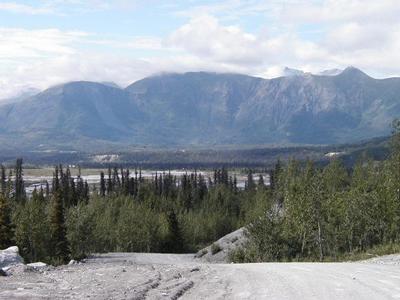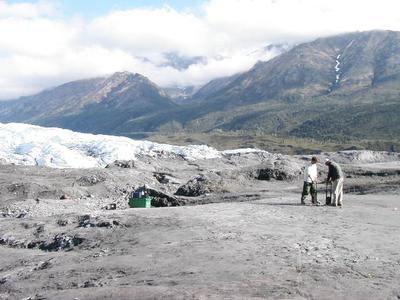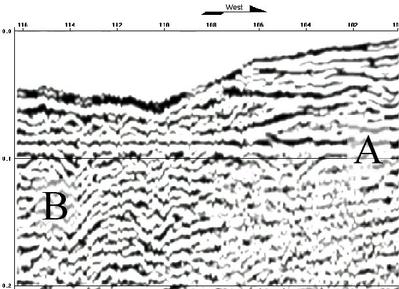17 July, 2001
Mud pits suck & ground-penetrating radar basics
8:00 p.m.
Life on the ice.. .. (almost)
During the summer, I try to wake up with the sun. So this morning, I woke up
at 2:30 a.m. and again at 4:30 and then at 5:30, each time looking at my
watch to realize it still wasn't time to get out of bed. My brain
understands that "day" has lost its meaning, but my body hasn't. Last night,
it never got dark... When I woke up at 2:30 a.m. to a gentle rain, it was
light enough for me to read without having to use a flashlight.
We set a relaxed pace today, arriving at the glacier around 10:30 a.m.
Sitting on a moraine overlooking the terminus (end) of the
glacier, Jeff Strasser (one of the principal investigators on the REU
project, and the person partially responsible for affording me the
opportunity to be here) outlined expectations to help keep the camp running
smoothly and safely. One of the cautions: stay away from the mud and work
in pairs.
We didn't have long to wait to find out why both of these precautions are
important.
Shortly after the safety briefing, Jeff instructed us to get to know the
glacier by looking for clues that would help us determine how the moraine we
had been sitting on had been formed. Ranae and I walked around the outwash
(meltwater from the glacier forming a stream as it emerges from
underneath the glacier) and were taking some snapshots when a panicked woman
approached, telling us that "A girl has fallen in a creavase and can't get
out. My husband is waiting with her." The woman's daughter showed us the
way. The girl hadn't fallen in a creavase (in which case rescue would have
been near impossible if someone had even known to look for her). Instead she
had tried to cross a mud flat on the hillside above the path to the glacier.
The twelve-year-old girl had gotten turned around and saw the quickest way to
the glacier was to walk across the mud flat. Apparently, after she sank into
the mud up to her knee, she tripped. One of her legs was buried to the knee,
one arm was buried to the shoulder. She had nothing to push against and so
couldn't get out.
Fortunately, her accident happened relatively close to the trail and she was
able to call for help. Fortunately, Cory and Mike had just finished
collecting data on the glacier and had a length of rope with them. We tossed
her the rope, she looped it under her arms and we pulled her free. It took
four grown-ups to free her from the mud. Her trapped shoe is still there.
Don't walk on the mud. Don't travel alone.... Any questions?
Science at work
11:15 p.m.
This afternoon, Greg, Nelson and I took a sample run of ground-penetrating
radar data.
There are three key parts to the ground-penetrating radar: a transmitter to
send out radar signals, a receiver to capture signals sent out by the
transmitter, and a computer to tell the transmitter when to fire and to
collect data from the receiver.
A transmitter fires an electrical signal into the ground. When the signal
reaches an object or layer with different electrical properties, part of the
signal is reflected back to the surface. These reflected signals are
captured by receivers on the surface. By measuring the time delay between
when the signal was sent and when it is received back at the surface, one can
infer the depth and location of the object or layer. With practice, it is
possible to infer a great many more details besides.
This afternoon, we hooked the transmitter and receiver to the computer and
measured a line about 20 m long on a "slump" overlooking the glacier (see
picture below). Nelson and I placed the transmitter and receiver 50 cm apart
and took measurements. We repeated the procedure 10 cm farther down the
line... again and again. Our data (with some fiddling) are also shown below.
Inferring the details in a picture is a bit like watching TV or listening to
songs that aren't coming in clearly. With practice, it becomes easier to
understand and interpret what is being shown and said. Interpreting these
data (Greg assures me) is a bit the same.
Cheers.
~SM

Matanuska Glacier and its outflow... The picture does not capture the magnifience of the area or the glowing blue ice.

The view of Matanuska Valley from the moraines at the end of the glacier is also breathtaking

Test run of ground-penetrating radar. I am holding the "receiver", Nelson is holding the "transmitter". The computer is located to the far left of the picture. The computer sets the guidelines for the data collection and collects the data.

Getting clean? Playing a silt puddle is no way to wash up. Silt gets everywhere!

Data from ground penetrating radar test The data was collected on a "slump", a slight depression where a chunk of land has sunk at the same time, appearing ready to slide the rest of the way into the river. "A" likely represents the water table, the level of ground water underneath the surface. "B" (and the other upside-down U-shaped squiggles) probably represent boulders buried underground.
Contact the TEA in the field at
.
If you cannot connect through your browser, copy the
TEA's e-mail address in the "To:" line of
your favorite e-mail package.
|
